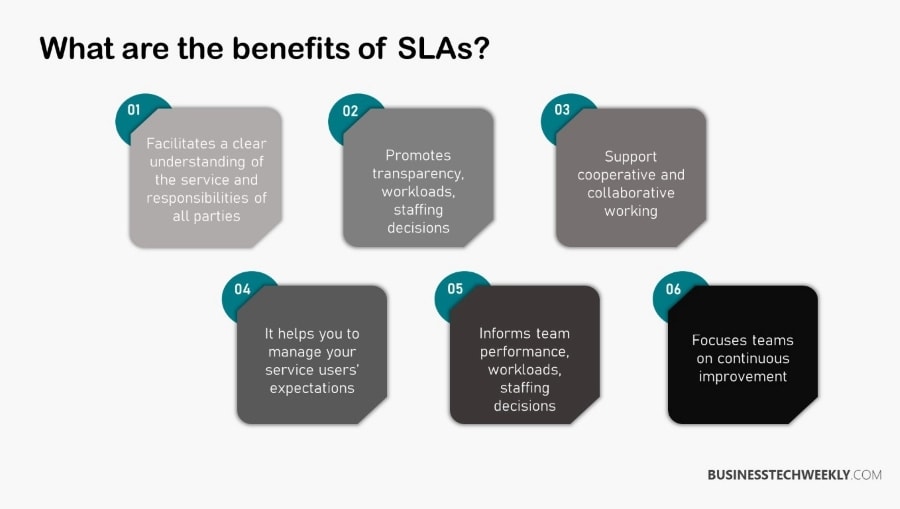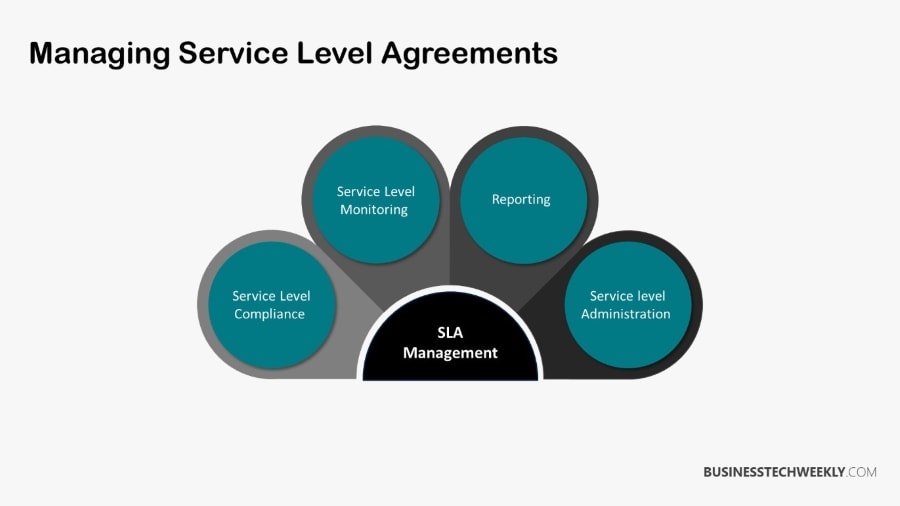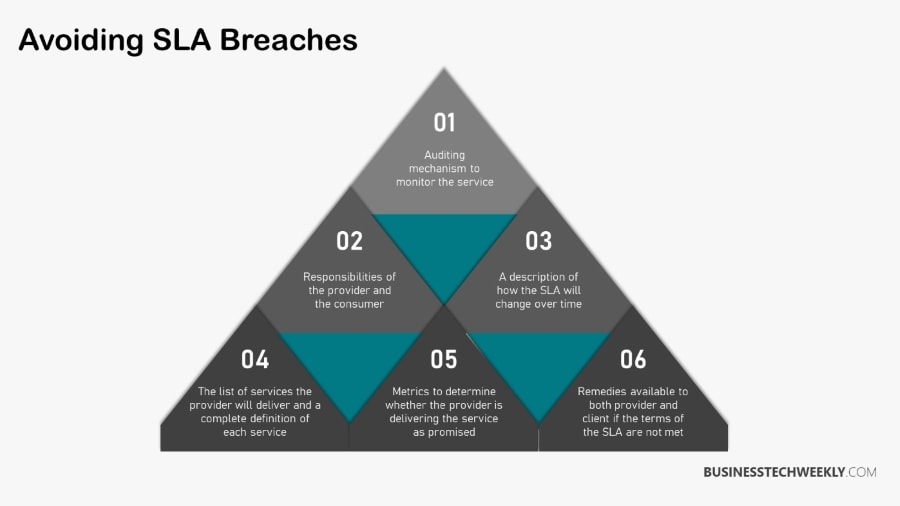Avoiding SLA Breaches and Managing what happens if your SLA is breached

Customer satisfaction is today more important for businesses than ever before. In today’s landscape, where there is virtually no difference between competitor pricing and features, outstanding customer service is a factor that makes a difference. Service Level Agreements (SLAs) are generally the main reference points for what a company promises to customers. However, as most businesses today have their data and technology managed by third parties, SLA breaches have become common.
Below, we explain what SLA breaches are and how companies can manage and handle them to avoid their consequences.
What are SLA Breaches?
Service Level Agreements, or SLAs, are contract documents that lay out the services and performance as agreed between the company and the customer. It describes the metrics both parties can use to measure service quality and lists the penalties and solutions that should be used when the provider fails to meet the agreed terms.
SLAs are ideal as the company commits to doing its best to meet the criteria and metrics described. However, when the service provider fails to achieve the promised targets and violates the SLA, it is called an SLA breach.
For example, suppose an internet service provider promises availability of 99% in its SLA. Any outage higher than 7.3 hours per month is considered a breach, provided it is within the provider’s control and not a result of third-party disruptions or natural disasters.

How to Avoid SLA Breaches?
Once the SLAs are crafted and sent to the customers, it is crucial to manage time and track the metrics accurately to ensure deadlines are always met. It is a balancing act to determine the right time to commit to SLAs. Here are some of the considerations for setting SLAs.
Setting Service Goals
If you are a small company with no legally binding agreements, your SLAs can be the same as your internal goals for response and resolution. However, if you have communicated SLAs to your customers, there are chances for breaches. Your goal should not be to meet the minimum level of service; you should instead set the goals more ambitiously than only avoiding breaches.
Aligning your goals at the same level as your SLAs won’t give you much room for error. Your SLA should be the highest waiting time acceptable for customers, but it should not be your measure of quality. It is best to set your response and resolution goals below the metrics set in SLAs to exceed customer expectations consistently.
RELATED: IT Support Contracts: What should be covered in your IT Support Agreements?
Understand Customer Groups
Before setting up SLA policies, you should see whether all your customers fall into a single group or need different policies. By understanding customer needs based on their contract or plan, you can take measures to deliver more personalized experiences.
Here are two common ways to segment customers:
- Segmenting by plan – You can prioritize high-value customers over those on a low-priced plan when you create different tiers based on plans. Though you need not set an SLA for free users, it is necessary to have agreements for enterprises. They also play a role in contract negotiations.
- Prioritizing VIP customers – Personalized SLA policies for high-value contracts can be implemented. Multiple SLA conditions help set specific deadlines for customers and situations.
Categorize Problems
Though all the customer issues are equally important, not all are similarly critical. You can consider categorizing problems by priority and set different SLAs for them to help teams prioritize customer requirements. With multiple SLA policies in place, your teams can get as granular as you would like to serve all your customers equally.
Listen to Customers
It is crucial to consider customer feedback when crafting SLA policies. If your customers complain about a slow response or are leaving negative feedback on satisfaction, you must review your agreements to check how you can meet customer expectations. You should also see why customers demand specific response times.
For example, critical processes like point-of-sale or banking may need faster response times and no waiting. Other things like entertainment applications may not require such quick responses, which means you can allocate resources to priorities.
Set Staffing Levels
You might be tempted to set your SLAs based on service availability, but the approach is incorrect. Instead, consider prioritizing customer experiences and staff the teams to meet the policies. If you encounter SLA breaches from an inability to fulfil customer expectations, you should consider hiring more people to handle timely requests.
Define OLAs
Operational Level Agreements (OLAs) are often useful for meeting SLAs, mainly when there are internal dependencies. These are agreements between teams to prevent internal bottlenecks. If an SLA is breached, customers are least bothered about whose fault it was. They only know that the obligation was not met. OLAs help teams work together to fulfil commitments made to customers.
Business Hour SLAs
When you don’t offer 24×7 support, you can consider setting SLAs that only consider your operating hours. For example, if your agents don’t work on weekends and you have an SLA with a 24-hour response time, customers sending a request on Friday noon should wait till Monday for a response. When you set your SLAs to business hours, the timer doesn’t keep running when the service is unavailable.
However, while this looks better, it is worth noting that customers keep waiting for a response throughout the weekend. They might not care about your working hours; they only know they did not get help yet. When you choose to report on business hour SLAs, you should take measures to address the customer experience for people trying to reach you after hours.
RELATED: Mastering Service Level Agreements: Best Practices for SLAs
Strong Problem Management
Solid problem management and continuous improvement practice support the efforts made to prevent occurrences of SLA breaches. By investigating the root cause and devising solutions and improvements, you can address any issue resulting in repetitive breaches. Regularly revisiting the SLAs ensures they are always updated to meet the changing needs and situations.

How to Manage an SLA Breach?
Despite making efforts to ensure your teams meet the SLAs and take the necessary steps to avoid breaches, an SLA breach is always possible. Systems can experience downtimes, unexpected situations can occur, tasks are dropped, and you may realize an overdue response to a customer.
Though this is not something you expect, there are solutions. As long as you are not breaching your SLAs continuously, customers are more interested in how you handle it instead of the breach itself.
To manage SLA breaches efficiently, here are some strategies you can follow:
Keep the clients informed
There is no point in delaying the delivery of bad news to your customers. It is best to be honest, and transparent about a breach and get in touch with the customer as soon as you foresee it. Even when the response is not overdue, you can take the initiative to talk to the client about the possibilities.
When communicating an anticipated SLA breach, try to be as open and straightforward as possible. Let them know what led to the breach and share your plans for handling the problem. Don’t forget to apologize for your failure at fulfilling the agreement. As the problem progresses, communicate the updates proactively and keep up with any other upcoming breaches.
Revisit your internal reminders and escalation set-up
Consider using automation and escalations to your advantage to ensure any SLA breach is instantly addressed. Take measures to ensure the right teams are reminded on time with an ability to act on it.
Ensure reminders are sent early enough to let the representative address the concern on time. Review the escalation set-up to verify that it involves the right people. Also, consider adjusting the management chain for a breach that occurs.
For example, you can implement a color-coding system with your CRM. Any instance of breached SLA can be represented with a red color, while the yellow color can signal the team’s time before it can convert into a breach. Green color can tell the teams that there is a lot of time to act on an SLA before it can be breached.
Such a system is easy to set up and helps service teams quickly overview what issues they should prioritize.
RELATED: How to measure your SLA: 5 Metrics you should be Monitoring and Reporting
Involve legal teams
When your SLAs have been included in legal contracts with your customers, it is essential to contact your legal team as soon as a breach occurs. They can help you follow the requirements for reporting these breaches and help manage customer expectations to avoid legal penalties. Escalations can be useful for notifying legal teams ahead of time to keep them in the loop for missed deadlines.
Review processes
If you are detecting SLA breaches consistently, it is good to look at the problem and try to reach the underlying cause behind it. See if it occurred because your team got overwhelmed. If yes, you can consider automating repetitive tasks to take some load off their head. Also, look at the internal imperfections that might be getting in the way.
If you can find any bottlenecks, devise methods to minimize their effects. Learning why SLA breaches occur is a critical step in ensuring you deliver expected levels of customer service.

Final Thoughts
SLAs are critical components of any business strategy as they help ensure customer satisfaction and quality of service. While it is challenging to avoid SLA breaches altogether, businesses can take measures and follow some best practices to prevent most of them and respond promptly to limit their effects on customer experiences.

